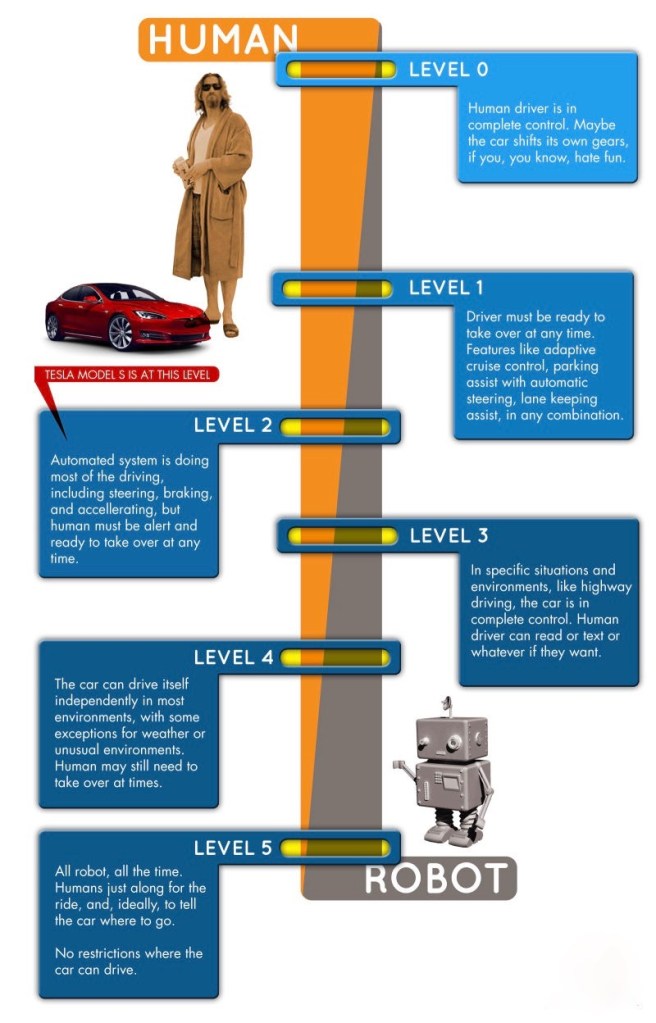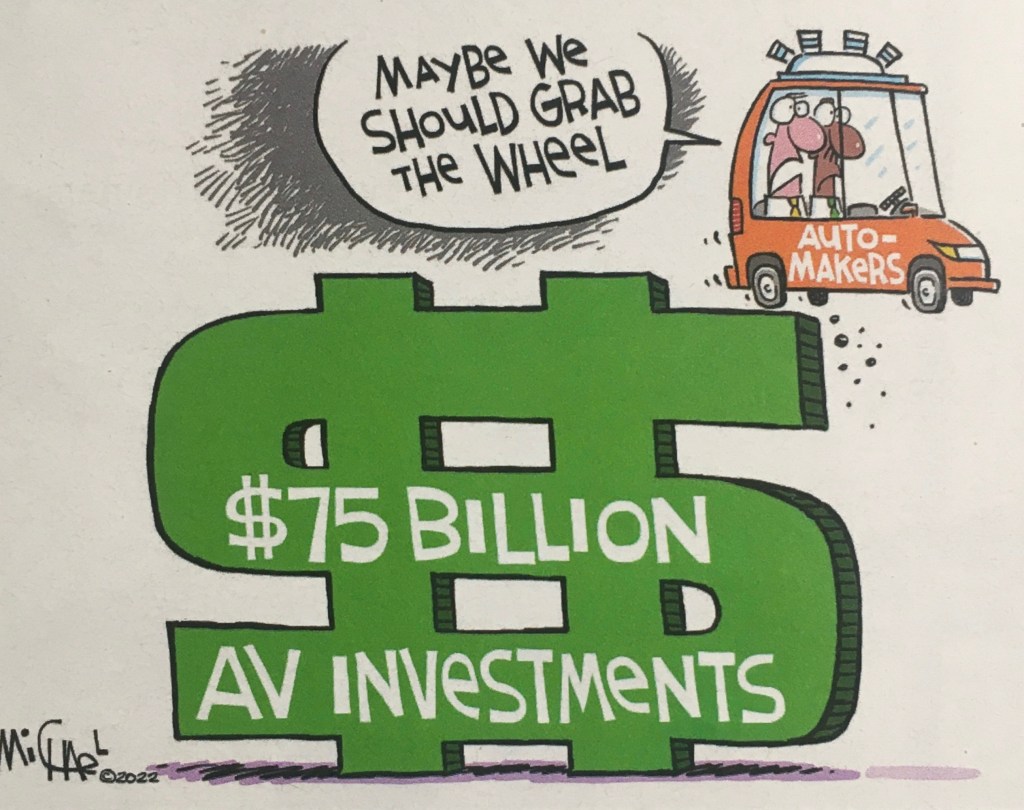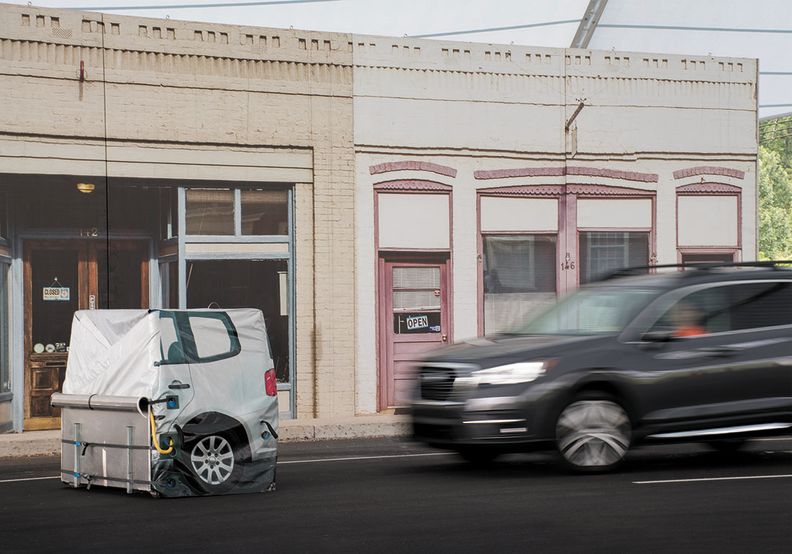Simanaitis Says
On cars, old, new and future; science & technology; vintage airplanes, computer flight simulation of them; Sherlockiana; our English language; travel; and other stuff
TO AV OR NOT TO AV? TO WHAT EXTENT?—YOUR VIEWS REQUESTED
I AM QUITE THE LUDDITE when it comes to personal transportation: My Honda Crosstour is ten years old; my Mazda Miata, a first-generation 1990.
Thus, I have little first-hand experience with new cars, indeed, with any produced in the past ten years. Despite this (or maybe because of it), I’m not particularly enthusiastic about AVs, automated vehicles, the self-driving kind.

SAE J3016 defines six levels of vehicle autonomy, from none to utterly driverless. We are currently probing Level 2.

My Miata and Crosstour are both Level 0s. I’ve driven a few cars with Level 1 features such as adaptive cruise control, lane-keeping assistance, and adaptive braking.
And my experience with Level 2 and above is limited to back in R&T days, that is, pre-2012, when I sat in an experimental Level 4 car as it clunked its way around an abandoned military base.
I was not impressed with it back then. Nor am I impressed, for example, with Tesla’s overhyped Level 2, as displayed in mixed recent videos.
Geez. These experiments on public roads??

Automotive News Speaks Out: In an October 31, 2022, editorial, Automotive News wrote, “Despite Billions Spent, AVs Have Long Way To Go.”

Automotive News reports, “The goal remains laudable: Autonomous driving promises to radically improve safety, boost fuel efficiency and free drivers to pursue what may be more productive activities. Yet the price of this technological pursuit has, at least according to Bloomberg estimates, reached a minimum of $75 billion and counting, with no end in sight and still only the vaguest promise of return on that investment.”
Strong words, though “vaguest promise” was softened less than a month latter with another editorial: “Automated Tech Can Save Lives—If Done Right,” Automotive News, November 21, 2022.

Automotive News notes, “A pair of reports last week show how two increasingly common safety technologies can make a difference.”
Emergency-braked Pickups. “The Insurance Institute for Highway Safety,” Automotive News says, “found that the rear-end crash rate of pickups equipped with automatic emergency braking was 43 percent lower than those without it. Given that modern full-size pickups have curb weights that tip the scales at 2 or even 3 tons, plus the weight of passengers, cargo and maybe a trailer, they can do extensive and deadly damage in a collision with other vehicles and pedestrians. That’s a lot of tonnage to stop, and the braking tech can mitigate some of the damage from human error — or prevent it.”
Forward-collision Warning and Automatic Braking. Automotive News continues, “The second study, a collaborative effort between government and automakers, found that rear crashes resulting in injury were reduced by 53 percent when vehicles had forward-collision warning and automatic emergency braking. With just forward-collision warning, that rate fell to 16 percent.”
Works in Progress. These advanced driver-assistance features, Automotive News notes, “are not perfect. Forward-collision systems have been known to fail at night or in low-light conditions, for example, and it is unclear how many casualties have occurred when advanced driver-assist tech was engaged.”
“Tesla’s Autopilot technology,” Automotive News reports, “remains under the microscope as more crash reports come in. But NHTSA does not have enough data to determine whether Tesla accounts for a disproportionate number of these crashes. The number of people using Autopilot incorrectly is another unknown factor.”
This, and we’re only a little into Level 2. Indeed, it seems we’re a long way, if ever, from Level 5.
A Request. In the meantime, though, I would like to hear from readers who’ve experienced using these and other advanced driver-assist features. What about lane-keeping assistance? How much trust is put into adaptive cruise control? What are your views on AV goals and progress?
Thanks in advance for your responses. ds
© Dennis Simanaitis, SimanaitisSays.com, 2022

My 2013 BMW has at least one “advanced” feature that I’ve turned off. Going into a curve at high speed the car would “warn” me by vibrating the steering wheel and then braking.
Doubly bad, as the vibration startles me while I’m concentrating on taking a curve at high speed and the braking induces understeer. This feature, to use a technical term, “sucks.”
There is another feature that I’ve used very seldom which is lane following. My “commute” is by foot, so I’m very, very rarely in bumper-to-bumper traffic or freeway traffic at a steady speed (I live near a lot of mountains). That being said, I remember the graphic on the dash /head-up display was good, and the feature worked pretty well with cruise control.
I’ve read really good things about “forward-collision warning and automatic emergency braking” and I’m a huge fan. Rear-end collisions kill a LOT of people and VERY often the collisions are the result of sleeping at the wheel / not paying attention. Straight- line recognition of an object ahead and braking is pretty straightforward (see what I did there?) technology.
I for one think we are a long way from level 5. Possibly we’ll never get there. The processing power of the human brain combined with the human eyes and ears is consistently underestimated.
Good points all .
I’m lucky in that I live way out West so I can safely drive a 40 year old car (I have other, older vehicles too that I use as daily drivers) without worrying about corrosion damage .
The flip side is : I’m getting older and some day may not want to drive yet I’ll still need to go to the store, doctor’s office and so on so maybe there’s a self driving ‘Transportation Pod” (ick) in my future……
Long live the No Frills Iron Bottom Motoring Tour ! .
-Nate
My elderly mother needed to replace her car. After some research, I found out Toyota had made new advanced safety systems (such as emergency braking, lane keeping assist, etc) standard equipment on recent models. We found a ’16 Corolla with these features, and Mom readily took to it. Well, except that there was a ninety degree bend halfway up her street with a tree looming at the corner. She mentioned it always set off the forward collision warning.
I’d personally go with whatever Consumer Reports or IIHS recommends as a proven incident preventer — I figure if it stops me from having one accident, it’s paid for itself. However, I think many AV accidents are a combination of tech shortfalls and unengaged drivers. The former will improve but never be perfect, yet the latter has the ultimate responsibility for vehicle operation. How do we keep the driver engaged and alert, when they’re becoming so disconnected from the drive by digital nannies?
I’m not going to be a big help, either (thought I wasn’t quite ready to call myself a Luddite, I guess I am). My regular driver is a 1999 Toyota Solara (inherited), which is so nice and reliable that I’d be stupid not to drive it until it quits. I do rent cars periodically though and they (mostly Hyundais and Nissans) usually have the lane-keeping function (which I tend to forget about) – the slight vibration of the steering wheel and/or the feeling there is a line of gravel on the road reminds me and is, I suppose, helpful. I learned that if you use your turn signal before going cross the line, it won’t bother you.
I bought my daughter a new Hyundai Kona and it has the whole package (though no auto-steer) and the rear camera (with cross traffic alert) is quite helpful in parking lots trying to see past monster trucks and giant SUVs. I’ve been afraid to test the emergency breaking, though.
I too suspect it will be a while until we get full self-driving cars, though reading (mostly older) Science Fiction (some of Heinlein’s stories featured auto-piloted cars – some even flew!) made the idea seem pretty handy. I think they’ll probably be usable on freeways first, where limited access and standardized design will play to their strengths.
Mark Williamson
I put 9,000 miles on a 2022 Volvo hybrid sedan, and now have a ’23.
Adaptive cruise control is the cat’s meow, use it all the time. It performed perfectly in both cars. If I’m behind a slower car, signal for and perform a lane change, the car accelerates to the set speed. It can bring the car to a stop in traffic then moves when traffic moves. If completely stopped for 3 sec or more, just touch resume or the throttle and cruise control is again engaged.
Lane keeping was usable in the 2022, better in the 2023, less “hunting.” It must see painted lane markers on both sides of the lane. You must plan for marker absence when you get to an exit or you drift right. In my experience it can’t be relied on at slower speeds on secondary roads. One big issue, the pressure required on the 2023 steering wheel is much too high compared to the ’22.
The collision avoidance seems to err on the safety side as it should, but somewhat intrusive, emergency braking and loud bell sounding. Backing into the garage – if I back up faster than 1 or 2 mph – it’s too sensitive, with different warning buzzers sounding and jolting the car to a stop, even with side clearance marginal but no obstructions behind. I’ve learned to creep :^). But the 2022 didn’t have this problem (?).
My other Volvo V70 3 pedal wagon with 220K miles, is level 0, but provides Volvo’s signature occupant survivability as a back up. Also, as comfortable as an old pair of shoes.
Even relatively innocuous level 1 features while possibly providing additional safety features can create a false sense of security. My previous Audi Q5 had the blind spot warning feature, which if used as additional info was useful. In colder weather with sleet and snow the sensors iced up and caused the system to shutdown. Fortunately there was a warning message on the instruments, but obviously the system could not be relied on. If it were part of a more advanced self driving feature this “failed” system could have resulted in an accident or might cause a more automated car not to be able to change lanes.
A number of years ago we were in Washington State driving the I5 in a Volvo with some self driving features. The lane keeping feature worked OK, faithfully keeping the car a set distance away from the white line along the edge of the road. Unfortunately at every exit it tried taking the car up the off ramp, faithfully following the white line!
In our neck of the woods, where we regularly have snow and the roads are sanded to help with slippery surfaces, and then scraped clean with snow plows a lot of our lane markings end up being quite faded until the annual repainting. Also sometimes in winter two lanes can become a single lane in places when we have a heavy snowfall, but in other places the original lane markings become visible, which could cause the car’s lane keeping feature to push the car over into potential trouble.
In my over 50 years of driving I have seen many strange behaviors by other drivers and I doubt the automated systems have not all been trained on. The other day I saw a new “one”, which I doubt the automated systems have been exposed to.
I’ve got lots to say, but it’s late and I want to get this reply in before I lose it. Essentially I am not in favour of AVs.
Thanks, knowledgable readers. I really appreciate your information. Do continue with your insights.
I agree that certain driver assists (FCW, adaptive cruise control, back up cameras) are useful, but I’m not in favor of AVs at this point.
It’s interesting to note that there is no great clamor for “full self-flying ” airliners, even though they operate in a highly controlled environment where every obstacle is mapped and (most) every other aircraft’s position is known. People want an experienced professional in control when they fly, but seem willing to share crowded roads with AVs “driven” by people with no mandatory training in the safe operation of such a vehicle.
That is a wonderful point about airplanes. I’ll remember that one!
Back when I worked at LAS and 747’s were the thing, a pilot didn’t ever land the aircraft, there was a radio setup called “GEORGE” that handled the actual landing for safety’s sake .
Luddism isn’t a bad thing if you’re smart about it (looks at the candlestick telephone next to the bed) , many new fangled things are better but don’t blindly go for whatever is new just because .
-Nate
I used to have a couple of friends who were air traffic controllers (since retired). Yes, there are airports where planes land without a pilot (as Nate noted below, but replies are not possible). However, in no case is there a situation or call for planes to fly completely without pilots, nor will there be any time soon. (your point above)
Can I interest you in an autonomous tractor? https://www.monarchtractor.com
I have family that are farmers in Minnesota. They use a version of “autopilot” but IIRC (discussion from 5 years ago) they are in the cabin. Similar to the part of Tesla’s autopilot that works: Driving in a straight line with no traffic, turning around at the same distance, and then driving back parallel to the first line.
This is of course a huge help to the farmers. Saves a lot of mental energy as they don’t have to concentrate super hard for hours at a time.
Excerpt from a just published test of the new Cadillac Lyriq:
“Our example also suffered a worrisome episode in which, after switching on, I could move the car forward and reverse but the steering wheel wouldn’t turn. After the car took a brief power nap, the trouble went away.”
https://www.wsj.com/articles/2023-cadillac-lyriq-an-electric-leap-forward-11669927707?mod=life_work_featured_strip_pos1
Oh, the trouble went away . . . sign me up? No.
I can’t see completely driverless cars basically ever. There are too many variables particularly in cities, and even-off road that make automated driving a nightmare to contemplate. Imagine trying to navigate a new or redeveloping neighbourhood that doesn’t have up-to-date maps. As a driver you can use trial and error to navigate an incompletely mapped area. An automated car would just declare that they can’t go there because there are no roads, or attempt to drive down an old routing that is no longer there.
My comment about off-road is not in relation to backwoods trails (although that would apply too), but parking lots. And what about a multilevel parkade.
I remember driving across the Bay-Oakland bridge a number of years ago and having the GPS insist that I make an immediate right turn off the bridge halfway across the bay. GPS systems have improved, but frequently I still see errors due to new development or changing street layouts due to development/redevelopment.